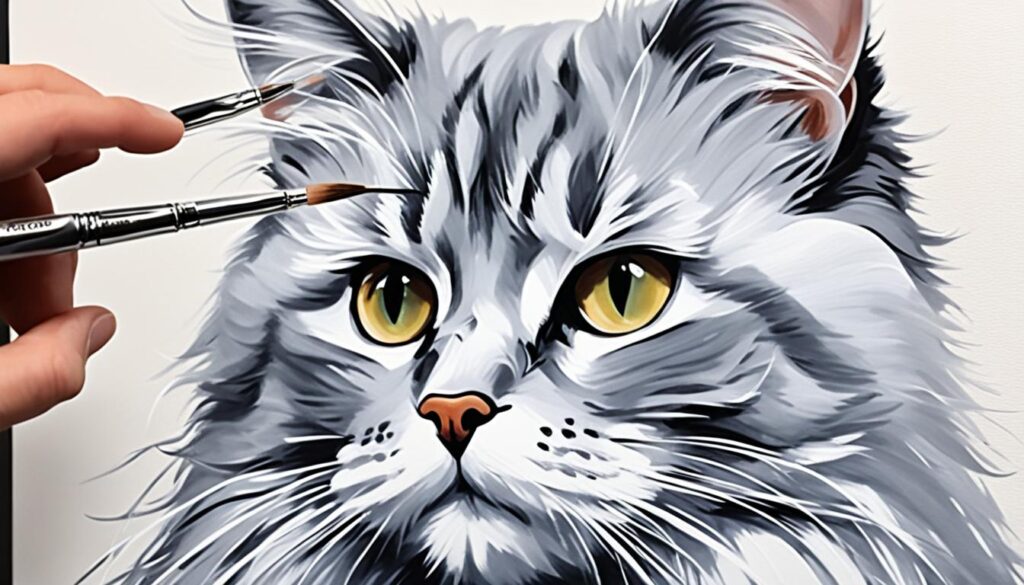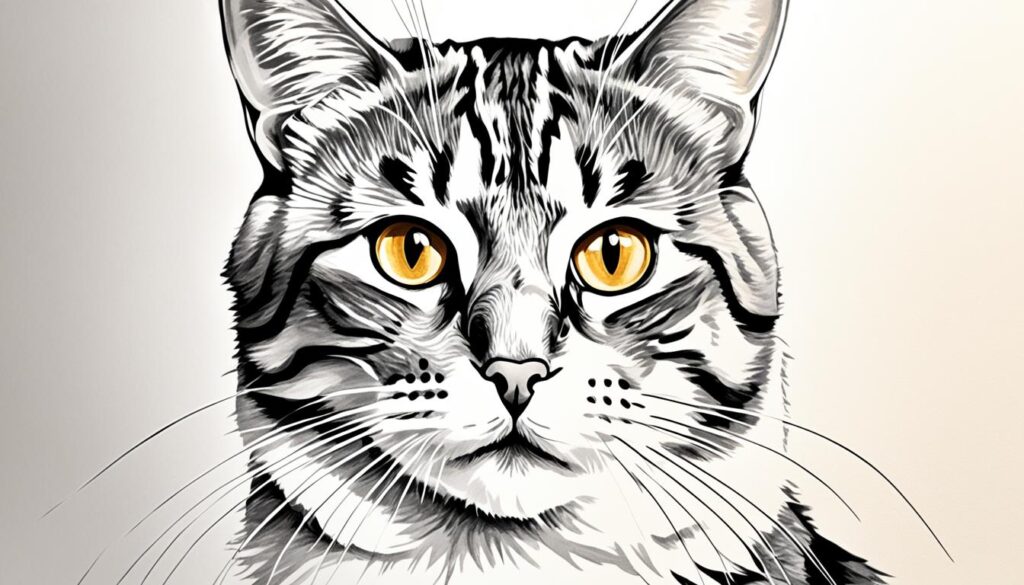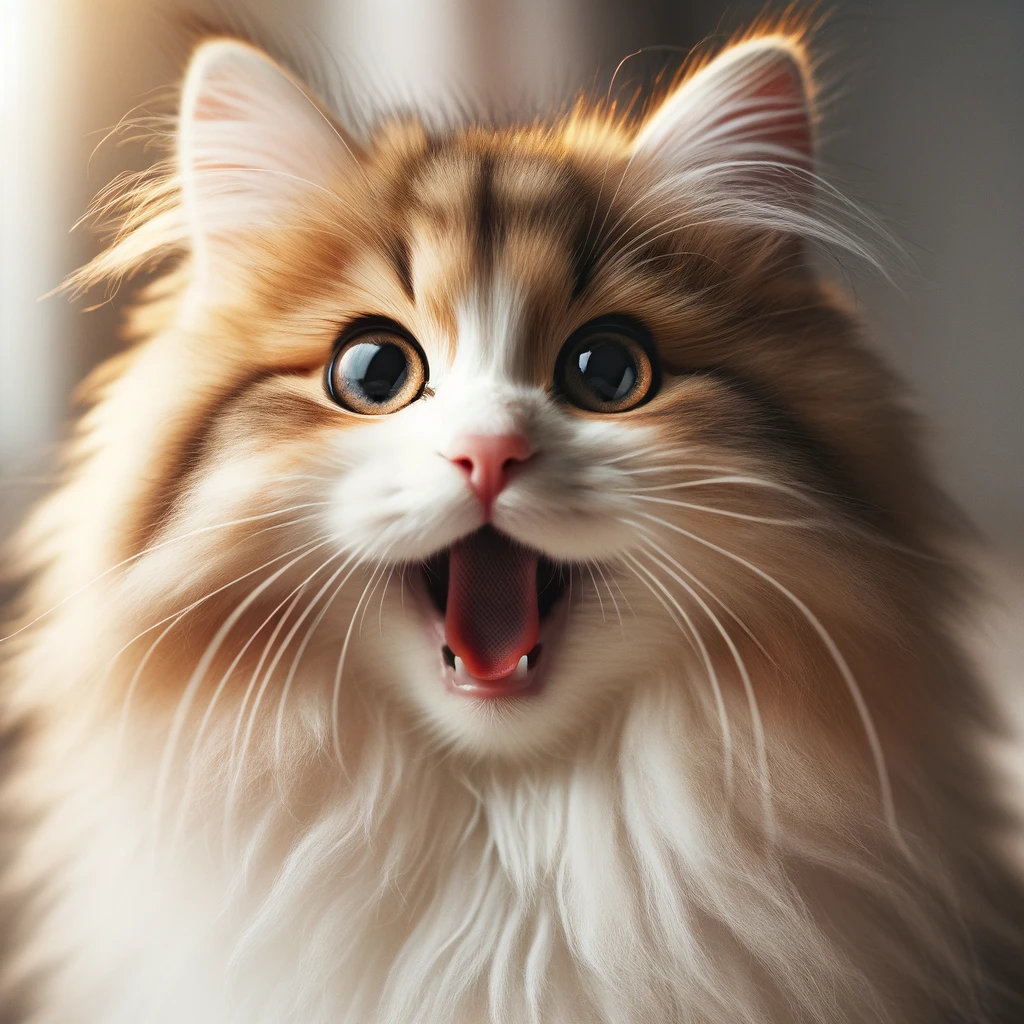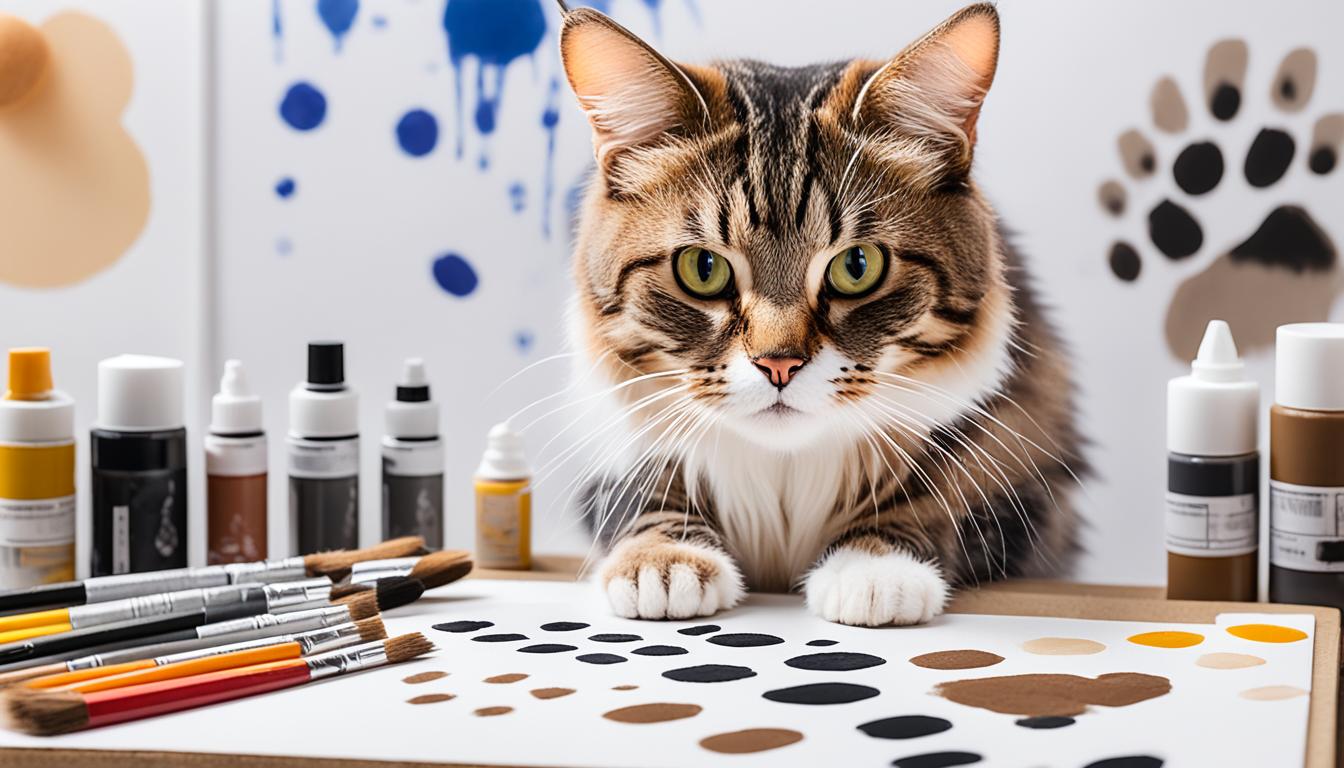As an Amazon Associate I earn from qualifying purchases.
Ever noticed how your furtastic friend can inspire a rainbow of emotions with just one whimsical whisker twitch? They’re not just pets; they’re paw-sitively perfect muses for our artistic endeavors! It’s time to put that feeling onto canvas, and what better subject than your very own fluffball? Let me walk you through a “purrfect” art escapade with this cat painting tutorial designed to help you portray your pet’s purr-sonality.
Embarking on this artistic venture doesn’t require nine lives of experience. Whether you’re a seasoned artist or a total novice, this guide will show you how to do a painting of your cat that’s bound to be the cat’s meow of your living room. We’ll meander through the joyful strokes, tackling fur, whiskers, and those captivating feline eyes. Get ready to unleash your inner artist and paint your cat portrait like a pro!
Key Takeaways
- Discover the joy and deep personal connection in immortalizing your feline friend on canvas.
- Learn simple, effective steps to create a cat portrait, regardless of your artistic background.
- Uncover the secrets of capturing the essence of your cat’s personality through art.
- Pick up cat painting techniques that will help even novices produce stunning results.
- Gain the confidence to start and finish a painting project that celebrates your unique bond with your cat.
Preparing to Paint Your Purrfect Pal
So, you’re ready to immortalize your feline friend on canvas? Good choice! Before dabbling in brushstrokes, it’s essential to lay the groundwork for your masterpiece. Let’s start by gathering your art arsenal, choosing the purrfect pose, and organizing your space. Think of it as prepping for a grand adventure—where the treasure is a DIY cat painting you’ll cherish forever.
Assembling Your Art Supplies
Quality counts, especially when it comes to art supplies. You don’t want your cat’s portrait to fade like old pajamas, right? Be selective with your paints, opting for vibrant acrylics or oils that will give your kitty the glow they deserve. Choose brushes that offer precision for those delicate whiskers, and don’t skimp on the canvas—this is going to be a showstopper on your wall. Below, find a breakdown of the essential supplies for crafting a cat painting that has nine lives in durability and charm.
| Supplies | Details | Reason for Choosing |
|---|---|---|
| Canvas | Stretched and primed | Provides a smooth surface for your creation |
| Brushes | Various sizes – fine to broad | Allows for detailed work and broad strokes |
| Paint | Acrylic or Oil | Long-lasting with rich pigmentation |
| Palette | Non-stick surface | For easy mixing and accessing colors |
| Easel | Adjustable | Keeps your canvas stable and provides comfort while painting |
Finding the Right Feline Pose and Photo
You know your cat’s personality is one-of-a-kind, so capture it! Stalk those candid moments like an expert photographer—or have a photoshoot with treats as bribes. Whether it’s a majestic stare out the window or a playful tussle with a ball of yarn, aim for a photo that showcases your cat’s spirit. Your portrait’s vibe depends on it, after all!
Setting Up Your Workspace
Your workspace is sacred—it’s where the magic happens! Find a spot where you can spread out and enter your artistic zone, free from the hustle and bustle of daily life. Good lighting is your ally; it brings clarity to your colors and shadows. Keep your tools within arm’s reach in an organized manner, because when inspiration pounces, you gotta be ready! With a space fine-tuned for creativity, you’re set to create a cat portrait that’ll have onlookers purring with admiration.
With your supplies at the helm, your ideal cat snapshot, and an environment that’s as cozy as a cat in a sunbeam, you’re officially ready to dive whiskers first into your DIY cat painting guide. Remember, just like a cat’s meanderings, the creative process might take some unexpected turns. Embrace them! Those unique twists and turns will infuse your piece with the authentic charm of your kitty’s special character.
Sketching Your Cat: The Blueprint for a Masterpiece
Let’s get the ball rolling—you’re about to sketch the most charming subject imaginable: your pet cat. Before diving in, it’s essential to grasp some art fundamentals to nail those adorable cat nuances. Fear not, as you’ll be a whisker away from perfecting your cat painting techniques!
Understanding Basic Cat Anatomy for Artists
Cat anatomy isn’t just about where to place the tail or how long to draw the whiskers. It’s about capturing the grace and fluidity of your feline friend in every stroke. Think of the skeletal structure, the muscle layouts, and yes, the fluffiness factor – these will be your building blocks of creating an accurate and lifelike portrayal.
Transferring the Photo to Canvas
Now, it’s time to transfer your kitty’s picture to the canvas. Whether you prefer the precise grid method or like to go freehand, make sure it reflects the pose that speaks volumes about your cat’s personality. This step is pivotal – it’s the sketch that sets the stage for your painting, so take your time to perfect this outline.
Detail Work: Capturing Your Cat’s Unique Features
No two cats are alike, and the same goes for their portraits. Pay close attention to the distinct features like the vibrant eyes, the patterns in the fur, and the characteristic curve of the tail. These details will breathe life into your piece, transforming a mere painting into a spitting image of your pet cat. Remember, patience is a virtue, especially when painting your pet cat.

As you hone in on those features, here’s a handy table of elements to consider that can make or break your cat representation:
| Feature | Importance | Tips |
|---|---|---|
| Eyes | The windows to the soul; captures emotion | Use reflective highlights to create depth |
| Whiskers | Adds realism; indicates movement | Keep them delicate and distinct from the fur |
| Fur Texture | Varies greatly; defines the coat | Mix different brush strokes to mimic the natural flow |
| Posture | Conveys the cat’s mood and personality | Study your cat’s typical poses for accuracy |
Ready your brushes, steady your gaze, and prepare for a purr-fect painting session. Keep these tips in mind, and you’ll be well on your way to creating a masterpiece that will have everyone saying, “Is that a photograph or a painting?” Enjoy every moment of bringing your feline muse to life on canvas!
How to do a Painting of Your Cat
Imagine transforming your feline friend into a timeless piece of art. With this detailed cat painting tutorial, you’ll learn the step by step cat painting process to create a meow-sterpiece that brings out the essence of your purr-tner in crime. Let’s dive in, brush first!

Before we break out the paint, let’s lay the groundwork. You’ll need patience, a splash of enthusiasm, and a sprinkle of creativity. Remember, it’s not just about the end product—it’s about enjoying the journey of crafting your cat’s portrait.
- Setting the Scene: Start by coating your canvas with a background hue that complements your cat’s fur. A neutral color can make your subject pop!
- Outline and Base: Gently sketch the outline of your cat using a light pencil or thin brush. This will act as the skeleton for your painting, ensuring all elements are proportionate and in place. Afterwards, block in the basic colors. Think of it as laying down the carpet before arranging the furniture.
- Fur Real: Time to tackle the fur, which is the soul of your feline’s appearance. Begin with broader strokes for the undercoat, then gradually build up to the finer fur details. Consider the direction the fur grows and lay your strokes accordingly.
- Eyes are the Window: Capture the life of your cat by painting the eyes with care. They should be expressive and hold a hint of the mischief that lies within.
- Whisker Wisdom: Using a fine-tipped brush, delicately add the whiskers and other fine details. This will bring a sense of realism to your piece.
- Highlight and Shadow: To give your painting depth and dimension, apply highlights and shadows thoughtfully. They can make your cat seem almost ready to jump off the canvas and curl up in your lap.
- Paws for Reflection: Step back and observe. Fine-tune any areas that need it, adding those final touches that bring your cat’s personality to the forefront.
Throughout the cat painting tutorial, remember the goal is to capture the spirit of your cat. Each stroke is a tribute, every choice of color a celebration, and every shimmer in the eyes a token of the joy they bring. Don your apron, charge your brushes, and let the step by step cat painting adventure begin!
Painting Techniques to Bring Your Cat to Life
Admit it, capturing the whimsical charm of your feline companion on canvas can add a purrsonal touch to your living space that truly speaks volumes. But before you dip your brush into a vibrant palette, let’s finesse your approach with some cat painting techniques that’ll make your pet cat leap off the canvas and curl up in the corners of your viewers’ hearts.
Color Mixing: Matching Your Cat’s Fur
Nothing screams amateur like an all-orange tabby when yours is clearly a mélange of burnt sienna and whispers of beige. Getting the shades right is not just a skill—it’s a tribute to your cat’s unique fur pattern. The secret? Don’t be afraid to play around. Mix that titanium white with burnt umber and a touch of ultramarine blue for the cool shadows. Remember, fur color is not just what’s on top; it’s an orchestral play of undertones and light.
Brushwork Basics: Texturing Your Cat’s Coat
Every stroke matters. Consider your brushwork as the bristling fur on your cat’s back; layer those textures till it feels like you could pet the painting. Deploy a variety of brushes for this artistic venture: a flat brush for wide, sleek areas and a fine-tipped one for those fairy-tale whiskers. Short, quick strokes with a dry brush can create the illusion of soft, fluffy fur, while long, fluid strokes can emulate the sleekness of a Siamese. Be playful, be precise.
Adding Depth and Dimension: Light & Shadow
Last but not the cat’s meow, light and shadow are your allies in adding dimension to your feline subject. Observe where the light nestles and the shadows fall on your cat. The gleam in their eyes, the contours of their face, and the depth of their body—all are shaped by the delicate dance of light and dark. A dab of pure white can signify that gleaming spot on the nose, while a deep gray can tuck itself into the soft underbelly shadows.
| Fur Tone | Mix Composition | Brush Type | Brush Technique |
|---|---|---|---|
| Light/Cream | Titanium white + touch of yellow ochre | Soft round | Layered, light strokes |
| Dark/Black | Payne’s gray + ultramarine blue | Flat stiff-bristled | Dry brush dabbing |
| Tabby Orange | Burnt sienna + titanium white | Angular flat | Short, swift strokes |
| Calico Blend | Custom mix matching distinct patches | Detail liner | Delicate fur detailing |
With these tips securely tucked under your apron, you stand ready to honor your pet cat in a montage of colors and textures that’ll leave onlookers captivated. So, wield your brushes with confidence and let those painting your pet cat techniques turn your feline muse into a resplendent relic of your artistic journey. Happy painting!
Step by Step Cat Painting: Bringing It All Together
You’ve sketched and you’ve swirled your brush in hues that capture the essence of your furry friend. It’s time to bring all those steps into a harmonious symphony to paint your cat portrait. Let’s weave through the tapestry that is the step by step cat painting process, ensuring not a single whisker is out of place on your masterpiece.
Like a conductor with a baton, you begin with a foundation, mapping out shapes and lines with a preliminary sketch. With each stroke, from the feline’s ear flick to the tip of its tail, your canvas whispers the promise of a portrait that’s uniquely yours.
- Sketching Your Subject: Starting with the light pencil marks to outline your regal feline.
- Layering the Background: Establishing the backdrop that will contrast against your cat’s fur.
- Base Coats: Applying the first layers of paint, considering the lightest colors to capture the sunny gleam in their eyes or the marble-esque swirl in their coat.
- Details, Details, Details: The magic is in the meticulous, adding fur textures and whisker wisps.
- Last-minute Check: Like cat paws on a soft couch, gentle retouches add finesse.
Painting is patience—watch your portrait evolve with each layer. A purr, a twitch of the nose, your brush dances and YOUR canvas becomes a window to another soul. Touch by touch, shade by shade, the personality of your feline friend pounces from the frame.
| Artistic Stage | Tools and Techniques | Pro Tip |
|---|---|---|
| Underpainting | Large brushes, diluted paint | Keep it light – you’re setting the tone, not cementing it. |
| Texture | Smaller, stiff-bristled brushes | Work in layers, just like a cat’s fur. |
| Detailing | Fine-tip brushes, meticulous eye | Focus on the eyes – they’re the window to the cat’s soul. |
| Finishing Touches | Soft brushes, light glaze | Highlights seal the deal; they bring out the life in your painting. |
Remember, each portrait tells a story. And like a cat sprawling lazily in a slice of afternoon sunshine, take your time to bask in the creation of your artwork. It’s more than a painting; it’s a tribute to your whiskered companion wrapped in affection and bold brushstrokes. Go on, let your portrait purr with personality.
Conclusion
As you stand back and admire your labor of love, let’s ensure that the charm and beauty of your cat portrait endure. With just a few steps more, you can preserve and share the essence of your whiskered companion captured on canvas. Pat yourself on the back; you’re almost ready to unveil your feline masterpiece.
Final Touches: Review and Refine
Take a moment for a thorough review of your cat portrait. Step back and observe from different angles and lighting—details often pop in the least expected places. If you spot anything amiss, now’s the time for those artful adjustments. Subtle refinements can make all the difference, enhancing not just the likeness but the spirit of your pet captured in this DIY cat painting guide you so brilliantly followed.
Preserving Your Artwork: Sealing and Framing
Once content with your creation, it’s crucial to protect it. A coat of varnish will seal your efforts, ensuring that the splendor of your cat’s coat, as depicted in your artwork, remains as vivid as their personality. And why stop there? Complement your artistic prowess by choosing a frame that adds that extra oomph and integration into your living space. After all, a well-preserved and framed portrait is an eternal tribute to your feline friend.
Showing Off Your Cat Canvas
Now, let the world—or at least your inner circle—revel in the joy of your create a cat portrait journey. Whether it graces your mantle, becomes a focal point in your gallery wall, or serves as a heartwarming gift, your cat canvas is a testament to your creativity and devotion. So, go ahead, and place your artwork where it sparks conversations, evokes smiles, and reminds you of the furry muse that inspired it all.
FAQ
What essentials do I need for a cat painting?
How do I pick the right pose for my cat’s portrait?
Any advice for setting up a painting-friendly workspace?
What are the basics of cat anatomy for artists?
Can you share a tip for transferring my cat’s image onto the canvas?
How do I paint fur detail so it looks realistic?
What’s the best way to mix colors for my cat’s fur?
Are there any brush types you recommend for painting cat fur?
How do I use light and shadow to add dimension to my cat portrait?
Any final tips for displaying my cat painting?
Paint a Cat Portrait with Acrylics – Step-by-Step Guide Artist Corner
As an Amazon Associate I earn from qualifying purchases.


[…] Capture Your Cat on Canvas: A Step-by-Step Guide Catnip Meow Hub […]